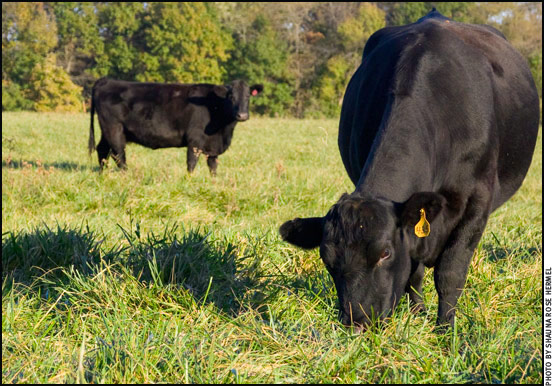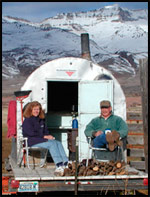MANAGEMENT...

Time for Nitrogen
MU Greenley Center visitors get timely tips on growing fall stockpiled feed for beef cows.
When it comes to winter feed for beef herds, applying a pound (lb.) of nitrogen to pastures in August gives a good return. A pound of nitrogen fertilizer makes about 20 lb. of forage dry matter, Justin Sexten, beef nutritionist, told Greenley Center Field Day visitors Aug. 9. Five wagonloads of visitors participated in the beef tour at the MU research farm east of Novelty, Mo.
Cattlemen can feed hay and distillers' byproducts to cows in the winter, but for ease of feeding and nutrient value, it's hard to beat stockpiled fescue pasture, said the University of Missouri Extension specialist.
"This is something you can take home and use now," Sexten told beef producers. "Mid-August until September 1 is the time to clip or graze pastures down to a 4-inch height." Then apply about 50 lb. of nitrogen per acre, and wait for the fall rains to activate growth. Read more.

Ron Torell with his wife, Jackie
Cow Camp Chatter
Calculating the value of a cow.
$800 calves, $1,100 yearlings, $1,000 market-ready (cull) cows, $2,000 aged bulls. Pair these exceptional prices with the smallest U.S. brood cow factory since the 1950s and many of us are considering expanding our cow herds.
The unrestrained production costs that accompany today's excellent market, along with the price of retaining and developing replacement heifers, and the difficulties of finding and purchasing quality bred cows at an affordable price, are all major concerns. When buying cows, don't let the current optimistic market set the purchase price for your investment or you may get caught up in the buy-high, sell-low trap. Consider all the long-term variables that contribute to what you can afford to pay for a cow. Read more.
Delayed Symptoms
Heat stress may cut calf crop next spring, MU specialist says.
Summer heat stress in cow herds may not show up until much later — at calving time, a University of Missouri (MU) Extension specialist told the crowd at the MU Greenley Center Field Day Aug. 9.
"I expect to get calls next spring from producers saying that their cows just quit calving," said Zac Erwin, livestock specialist, Monticello, Mo. Heat stress affects both cows and bulls during breeding season. Bulls go bad, failing to breed cows, and the cows fail to maintain pregnancies. While heat stress occurs most years, it was worse this year, with heat indexes higher than usual. Read more.
Best Practices
Range management specialist reviews best practices
for emergency haying, CRP grazing.
Several counties in Kansas have been approved by the U.S. Department of Agriculture (USDA) for emergency haying and grazing of Conservation Reserve Program (CRP) acreage due to the extreme drought and shortage of forage this year.
Several factors are important when haying or grazing prairie hay this summer, said Walt Fick, K-State Research and Extension range management specialist.
"If producers haven't cut their hay yet, I would encourage them to do so soon. Harvest date is the most important management decision affecting hay production. Timing affects production, quality, composition, amount of regrowth and subsequent plant vigor," Fick said. Read more.

Kris Ringwall
Beef Talk
Prepare to age and source your calves correctly.
Another glaring example of an almost missed opportunity arrived the other day. Sixty-seven head of cattle were sent to harvest. During the process, the cattle numbers were read and verified. However, the alarms sounded and people jumped when the numbers that were in the harvest process did not match the shipping manifest.
Eleven of the 67 steers where not on the manifest. This scenario is not a happy one. At a minimum, the 11 head would lose any added value when it comes to age- and source-verified beef and associated beef products. The 11 head put at risk all 67 steers because, in some situations, the cattle in the lot are set aside and processed as cattle that are not age- or source-verified. Read more.
New Products
Industry affiliates provide a wide array of products and services to assist you on the farm and ranch. Here's an assortment of new products to hit the market recently.
- Trailer flooring options
- New feed ingredient definition
- Dual-auger-design grain carts
- Automation row crop technology
- Wheeled hazardous area light tower
- Superhero auto-darkening welding helmet
Fingerprinting Fugitive Dust
Each community of soil microbes has a unique fingerprint that can potentially be used to track soil back to its source, right down to whether it came from dust from a rural road or from a farm field, according to a U.S. Department of Agriculture (USDA) soil scientist.
Ann Kennedy, at the Agricultural Research Service (ARS) Land Management and Water Conservation Research Unit in Pullman, Wash., studies the biological properties of soils that affect wind erosion. She analyzes the soil for the fatty acid or lipid content from the community of soil microbes living in the soil. It is this lipid content that forms the living community's fingerprint. Read more.
Angus Advisor
Click here for July herd management tips from cattle experts across the nation. Advice separated by region.
[Click here to go to the top of the page.]











